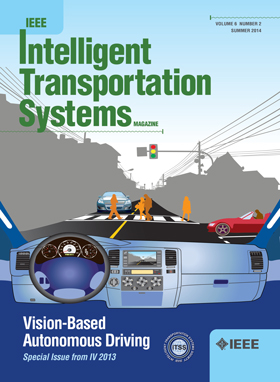Vehicle Classification Based on Multi-Frequency Resistance and Reactance Magnetic Profiles
IF 7.9
1区 工程技术
Q1 ENGINEERING, CIVIL
IEEE Transactions on Intelligent Transportation Systems
Pub Date : 2025-02-13
DOI:10.1109/TITS.2025.3537137
引用次数: 0
Abstract
This paper presents the application of inductive loop (IL) sensor technology to classify vehicles in traffic lanes. Two wide and two slim IL sensors were installed in the traffic lane. The wide and slim IL sensors feature distinct structural designs and varying levels of sensitivity. An advanced multi-frequency impedance measurement (MFIM) system was used to operate the IL sensors. For a passing vehicle, the impedance of every IL sensor at three different operating frequencies is computed and finally recorded at a sampling frequency of 1 kHz. Each of the 12 recorded signals provides a complex-value vehicle magnetic profile (VMP). Based on the VMPs from two IL sensors positioned one after the other, an accurate measurement of vehicle speed is obtained. Furthermore, the system can capture images of vehicles. A reference database of VMPs was created for various vehicle categories. The software selects 10 statistical features from each real and imaginary VMP part. Eight machine learning algorithms were implemented using ready-made Python3 implementations. Cross-validation accuracy was tested for five feature configurations, including slim and wide IL sensors. The Random Forest (RF) algorithm, utilizing 20 features from the complex VMP, achieved an accuracy of 99.8 % for the wide IL sensor. No errors were made by the Voting Classifier and RF algorithm when they incorporated a fusion of features from complex VMPs with MFIM system, utilizing both slim and wide IL sensors.基于多频电阻和电抗磁剖面的车辆分类
本文介绍了电感回路(IL)传感器技术在车道车辆分类中的应用。在交通车道上安装了两个宽的和两个细的IL传感器。宽而薄的IL传感器具有独特的结构设计和不同的灵敏度水平。采用一种先进的多频阻抗测量(MFIM)系统对IL传感器进行操作。对于经过的车辆,计算每个IL传感器在三种不同工作频率下的阻抗,并最终以1khz的采样频率记录。12个记录信号中的每一个都提供了一个复值车辆磁剖面(VMP)。基于两个相邻位置的IL传感器的VMPs,获得了精确的车速测量值。此外,该系统还可以捕获车辆图像。建立了不同车辆类别的VMPs参考数据库。该软件从每个虚和实VMP部分中选择10个统计特征。使用现成的Python3实现实现了八种机器学习算法。交叉验证的准确性测试了五种特征配置,包括超薄和宽IL传感器。随机森林(RF)算法利用来自复杂VMP的20个特征,对宽IL传感器实现了99.8%的精度。当投票分类器和RF算法将复杂VMPs的特征融合到MFIM系统时,使用了细长和宽IL传感器,没有产生错误。
本文章由计算机程序翻译,如有差异,请以英文原文为准。
求助全文
约1分钟内获得全文
求助全文
来源期刊

IEEE Transactions on Intelligent Transportation Systems
工程技术-工程:电子与电气
CiteScore
14.80
自引率
12.90%
发文量
1872
审稿时长
7.5 months
期刊介绍:
The theoretical, experimental and operational aspects of electrical and electronics engineering and information technologies as applied to Intelligent Transportation Systems (ITS). Intelligent Transportation Systems are defined as those systems utilizing synergistic technologies and systems engineering concepts to develop and improve transportation systems of all kinds. The scope of this interdisciplinary activity includes the promotion, consolidation and coordination of ITS technical activities among IEEE entities, and providing a focus for cooperative activities, both internally and externally.
 求助内容:
求助内容: 应助结果提醒方式:
应助结果提醒方式:


